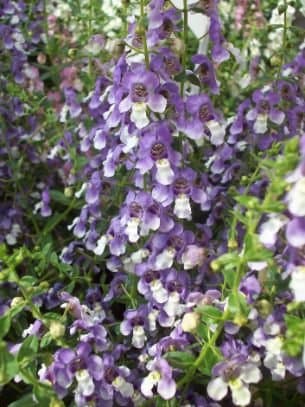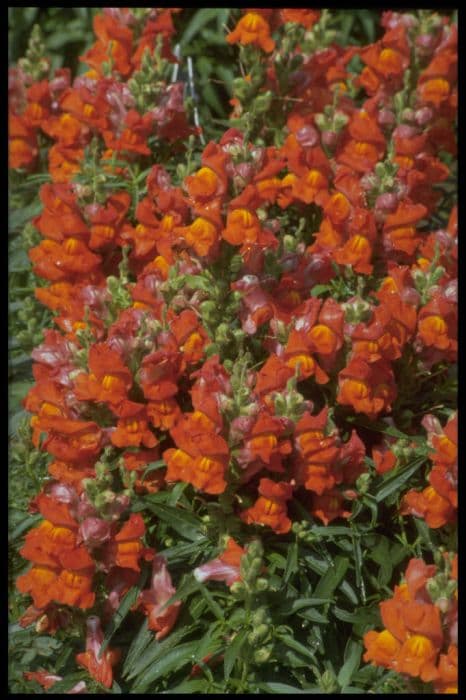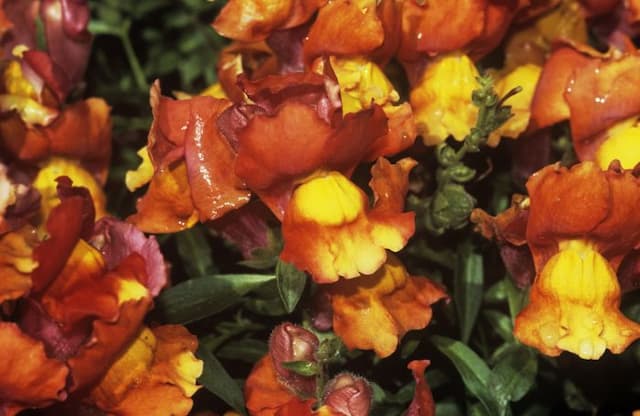Foxglove Digitalis 'Lucas'

ABOUT
Digitalis 'Lucas', commonly known as Foxglove 'Lucas', has a striking appearance characterized by a series of tubular flowers that bloom in a beautiful gradient from the base upwards. These blossoms come in a range of colors, often displaying shades of pink, purple, or white, and are marked with speckled patterns inside, giving them a speckled throat. The flowers are neatly arranged around a central stem, which is sturdy and upright, giving the plant an elegant and vertical visual appeal. The foliage of Foxglove 'Lucas' is made up of a rosette of oblong leaves that are somewhat large and have a slightly furry texture. These leaves are a rich green color, which provides a lush backdrop for the dramatic flowers. The leaves may have a softly serrated edge, contributing to the textured look of the plant overall. As the flowers of the Foxglove 'Lucas' mature, they often open progressively, with the lowest flowers on the spike blooming first and the progression continuing upward over time. This sequential blooming adds to the continual interest in the garden as it ensures a longer flowering period. The plant has a robust habit and when in bloom, its flower spikes are a prominent feature, easily catching the eye due to the dense cluster of blooms. Its striking blooms make it a favored choice for adding vertical interest to gardens and landscapes, and it is often visited by bees and hummingbirds, which are attracted to the tubular flowers for their nectar. Overall, Foxglove 'Lucas' is a distinctive and attractive plant, known for its showy flower spikes and appealing foliage, which offers visual interest and an element of cottage charm to outdoor spaces.
About this plant
 Names
NamesFamily
Plantaginaceae
Synonyms
Lucas Foxglove
Common names
Digitalis 'Lucas'.
 Toxicity
ToxicityTo humans
The Digitalis 'Lucas' belongs to the group of plants commonly known as foxglove. All parts of the foxglove plant are toxic to humans if ingested. Foxglove contains cardiac glycosides, which affect the heart. Symptoms of foxglove poisoning can include nausea, vomiting, diarrhea, headache, abdominal pain, dizziness, confusion, weakness, changes in vision, and cardiac disturbances. Severe poisoning can result in heart failure and death. Immediate medical attention should be sought if a person has ingested any part of a foxglove plant.
To pets
The Digitalis 'Lucas', also known as foxglove, is toxic to pets, including dogs and cats. The entire plant, including the leaves, flowers, and seeds, contains cardiac glycosides that can cause severe illness or even death if ingested. Symptoms of foxglove poisoning in pets may include vomiting, diarrhea, drooling, abnormal heart rate, cardiac arrhythmias, weakness, collapse, tremors, seizures, and potentially, death. Pet owners should seek veterinary care immediately if their animal has eaten any part of a foxglove plant.
 Characteristics
CharacteristicsLife cycle
Biennials
Foliage type
Deciduous
Color of leaves
Green
Flower color
Pink
Height
2 feet (0.61 meters)
Spread
1 foot (0.3 meters)
Plant type
Herb
Hardiness zones
4
Native area
Europe
Benefits
 General Benefits
General Benefits- Aesthetic Appeal: Digitalis 'Lucas', commonly known as Foxglove 'Lucas', features tall spikes of tubular flowers that add vertical interest and a splash of color to garden settings.
- Attracts Pollinators: The flowers are known to attract bees, butterflies, and hummingbirds, supporting pollinator populations.
- Easy to Grow: Foxglove 'Lucas' is relatively easy to care for, requiring minimal maintenance once established in the appropriate conditions.
- Shade Tolerance: This plant can thrive in partial shade, making it a valuable addition to shade gardens where other flowering plants may struggle.
- Cottage Garden Style: Foxglove 'Lucas' fits well into cottage-style gardens, contributing to a relaxed and charming garden aesthetic.
 Medical Properties
Medical Properties- Cardiac glycosides: Digitalis 'Lucas', known commonly as Foxglove, contains cardiac glycosides which can strengthen heart muscle contractions and regulate heartbeat.
- Heart failure treatment: The active compounds like digoxin extracted from Foxglove are used to treat certain heart conditions, particularly congestive heart failure.
- Arrhythmia management: It has been historically used to correct irregular heartbeats when used in precise dosages under medical supervision.
 Air-purifying Qualities
Air-purifying QualitiesThis plant is not specifically known for air purifying qualities.
 Other Uses
Other Uses- Indicator Plant: Due to its sensitivity to changes in soil conditions, foxglove can be used as an indicator plant to signal deficiencies in soil or the presence of certain pollutants.
- Textile Dyeing: Foxglove can be used for dyeing fabrics, as it contains certain pigments that can impart colors ranging from green to brown.
- Garden Design: Foxglove is commonly used in garden design for vertical interest and color, and because it attracts pollinators like bees and hummingbirds.
- Folklore and Symbolism: In folklore, foxglove is associated with magic and fairies, and is often included in gardens for its mythological significance and symbolism of protection.
- Photography Prop: The striking flowers of the foxglove make it a popular choice as a photography prop, particularly in macro and garden photography.
- Teaching Aid: Educators in botany and horticulture may use foxglove to teach students about plant growth, structure, and taxonomy due to its distinctive features.
- Natural Pesticides: Some gardeners plant foxglove as a companion plant to deter pests, although its effectiveness is mostly anecdotal and not its primary use.
- Culinary Garnish: While the plant is toxic if consumed, flowers of foxglove may be used for ornamental purposes as a garnish in upscale culinary presentations (with caution and clear non-edible labeling).
- Eco-friendly Confetti: Dried petals of foxglove can be used as biodegradable confetti for outdoor celebrations, reducing environmental impact compared to traditional confetti.
- Artistic Inspiration: Botanical illustrators and artists may draw inspiration from the foxglove due to its distinctive and dramatic flowers.
Interesting Facts
 Feng Shui
Feng ShuiThe plant commonly known as Foxglove is not used in Feng Shui practice.
 Plant Symbolism
Plant Symbolism- Healing: The Common Foxglove (Digitalis) has been used medicinally to make digitalis, a drug that treats heart conditions, symbolizing the power of healing.
- Bewitchment: Foxglove is also traditionally associated with magic and folklore, often linked to the faerie world, suggesting a symbolism of bewitchment and allure.
- Insincerity: In the language of flowers, foxgloves can represent insincerity, possibly due to the plant's toxic nature and the contrast between its beautiful appearance and poisonous properties.
- Toxicity: As a highly toxic plant when ingested, foxglove symbolizes danger and the idea that something beautiful can also be harmful.
 Water
WaterWater your Foxglove 'Lucas' deeply but infrequently to encourage deep root growth. Typically, this means watering to a depth of at least 1 inch once a week, but this can vary depending on climate and soil conditions. During hot or dry spells, you may need to water every three to five days. Ensure the soil has dried out somewhat between waterings, as Foxglove 'Lucas' does not like to be waterlogged. It is always better to err on the side of underwatering rather than overwatering, as too much moisture can lead to root rot or disease.
 Light
LightFoxglove 'Lucas' thrives in partial shade to full sunlight. For the best growth and flower production, plant it where it can receive morning sunlight and afternoon shade, particularly in hotter climates. In cooler climates, Foxglove 'Lucas' can handle more sun throughout the day. Avoid placing it in deep shade, as this can impede its ability to bloom.
 Temperature
TemperatureFoxglove 'Lucas' prefers a temperate range and can tolerate a minimum temperature of around 40 degrees Fahrenheit. The ideal temperature range for this plant is between 60 and 75 degrees Fahrenheit. However, it is a hardy plant that can endure brief periods of colder weather, down to about 30 degrees Fahrenheit, and higher temperatures when well-watered.
 Pruning
PruningPruning Foxglove 'Lucas' is largely to remove spent flower spikes, which can encourage additional blooming. Prune back the flower stalks after the blooms have faded, but you can leave some if you wish the plant to self-seed. The best time for pruning is late summer or early fall. Occasionally, it's also necessary to remove any dead or diseased foliage to maintain plant health.
 Cleaning
CleaningAs needed
 Soil
SoilFoxglove 'Lucas' thrives in well-draining soil rich in organic matter, with a slightly acidic to neutral pH between 6.0 and 7.0. A mix of loam, compost, and peat or sand would create an ideal environment for robust growth.
 Repotting
RepottingFoxglove 'Lucas' generally does not need regular repotting as it is a biennial plant. After its second year, the plant typically completes its lifecycle, so repotting might only be necessary if it's grown as a perennial in a container.
 Humidity & Misting
Humidity & MistingFoxglove 'Lucas' is adaptable but prefers average to high humidity levels. Ensure good air circulation to prevent diseases caused by excessive moisture.
 Suitable locations
Suitable locationsIndoor
Use bright, indirect light and ensure soil drainage.
Outdoor
Plant in partial shade, enrich soil with organic matter.
Hardiness zone
4-8 USDA
 Life cycle
Life cycleDigitalis 'Lucas', commonly known as Foxglove 'Lucas', begins its life cycle as a seed, which upon germination in early spring develops into a basal rosette of downy leaves. The plant prefers well-drained soil and partial shade to thrive. During its first year, it focuses on vegetative growth, building up reserves in its root system. In its second year, typically in late spring to early summer, it sends up a tall spike adorned with tubular bell-shaped flowers that range in color from pink to purple, attracting pollinators such as bees. After pollination, the flowers produce small capsule-like fruits that release numerous tiny seeds for propagation. The parent plant often dies after seed production, completing its biennial cycle, although under certain conditions, plants can behave as short-lived perennials.
 Propogation
PropogationPropogation time
Early spring
The most popular method of propagating Digitalis 'Lucas', commonly known as Foxglove, is by sowing seeds. The best time for sowing Foxglove seeds is typically in late spring to early summer, after the threat of frost has passed, or during fall to allow for a period of cold stratification which can help with germination. For a successful propagation, lightly press the seeds onto the surface of a well-draining soil mix, as they require light for germination. Keep the soil moist but not waterlogged and maintain a temperature of around 70 degrees Fahrenheit (21 degrees Celsius). Under the right conditions, seeds usually germinate within 2-3 weeks. Once the seedlings are large enough to handle, they can be transplanted into individual pots or directly into the garden.









